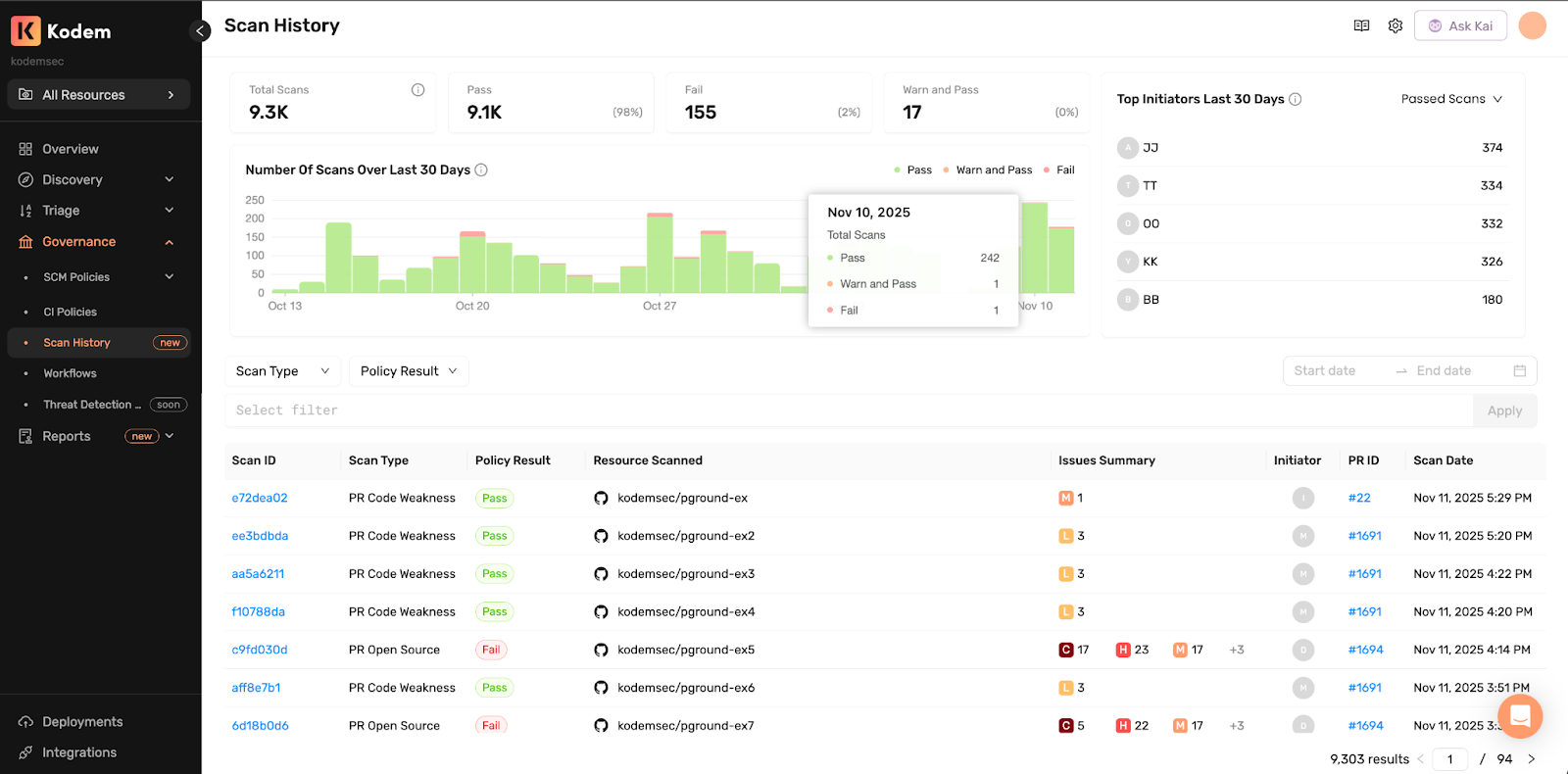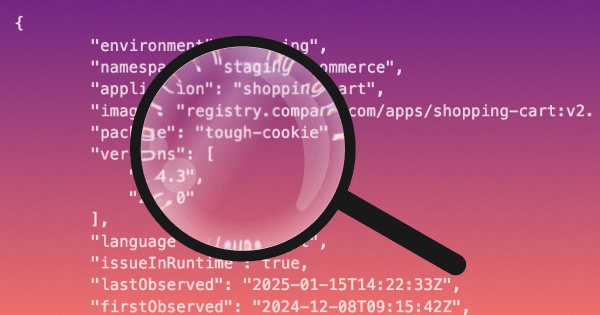Keep Risk Out of Main: When Security Policies Actually Help Development
Platforms can block merges when automated security checks fail, but they don't show whether your SCM policies are changing behavior over time. Kodem runs runtime-enriched PR/MR checks for code weaknesses, exposed secrets and open-source vulnerabilities, then turns policy outcomes into visible progress while work happens. Scan History reveals security trends across initiators and provides direct PR/MR links, so developers can see their own progress while AppSec blocks risky merges and investigates outcomes through detailed Kodem scan reports.


What Developers See From Check to Trend
When you push code, Kodem runs policy checks and blocks risky merges with detailed scan reports showing exactly what's wrong, how to fix it, and which issues matter most in production. After merging, Scan History shows your personal security improvement over time with links to track your historical scans.
What AppSec See From Policy to Trend
Scan History turns every check into security trends you can filter and analyze. See which initiators consistently pass, fail or need multiple attempts. Filter by policy result, scan type or resources aligned with your SCM structure, GitHub orgs and topics, Azure Repos projects and orgs, private or public repos and so on. Watch how teams handle runtime-critical issues versus indirect dependencies. Track which policies create lasting behavior change versus just blocking code. Move from one-off enforcement to understanding whether your security investment is actually working.
Policies that Change Behavior
The goal isn't just blocking bad code, it’s creating lasting security behavior change. Configure Source Control Management (SCM) policies in Kodem that matter in development, not just security enforcement.
- Require a fix version to exist before flagging vulnerabilities.
- Raise the bar by severity and factor in exploitation maturity and EPSS scores.
- Give extra weight when packages are direct dependencies.
- Key off OWASP categories and CWE IDs for code weaknesses.
- Enforce license terms or block known malicious packages.
The result is guidance developers can act on and enforcement that only blocks merges that should be blocked.
Positive behavior change looks like:
- Developers passing checks on the first attempt more often.
- Time-to-green decreases as teams learn faster fixes.
- Repeat failures for the same issue types are reduced.
- Proactive security practices are increasing.
What platforms can't answer:
- Are developers getting better at security over time?
- Is this policy teaching teams, or just blocking them?
- Which teams are improving vs. struggling with the same issues?
Patterns that Prove Improvement
Since policy scans of PRs/MRs occur before merge, the scoreboard reflects your organization's security posture at the gate:
- Pass rates trending up across recent days.
- Warn-and-pass reducing as teams fix earlier.
- Time to green falling from first failed check to passing commit.
- Recurring failures spotted by repository or org, with PR links to see what fixed them.
- Which initiators improve week after week and where second attempts were needed.

What AppSec Can Answer in Seconds
- Which resources are passing on the first attempt.
- Which initiators regularly produce failing checks and how quickly they recover.
- Which policies catch the most issues, such as malicious packages, exposed secrets and license violations.
- Where runtime-used packages are driving the most remediation action.
All of it traceable to a PR/MR with the issue summary and the time it ended.
Outcomes in Practice
Developers see their progress in passing and warn-and-pass scans and can investigate past successful remediation through PR/MR links. AppSec gets visibility into organizational security trends and guardrails that stop risky merges. Leaders get clear progress on security behavior change while work happens.
Blog written by
Gal Sapir
With six years of technical writing expertise in the SaaS industry, Gl specializes in translating complex technical concepts into clear API documentation, user guides, technical tutorials and product updates. Her collaborative approach with cross-functional teams ensures technical accuracy while delivering clear content that effectively communicates across diverse audiences.
More blogs

From Reachability to Reality: Proving Vulnerable Code was Executed & Exploited in Production
Memory analysis plays a critical role in turning kernel-level signals into function-level proof of execution. See which vulnerable functions actually run in your environment, cut noise and prioritize risk that exists (and is exploitable) in your running application.
A Primer on Runtime Intelligence
See how Kodem's cutting-edge sensor technology revolutionizes application monitoring at the kernel level.
Platform Overview Video
Watch our short platform overview video to see how Kodem discovers real security risks in your code at runtime.
The State of the Application Security Workflow
This report aims to equip readers with actionable insights that can help future-proof their security programs. Kodem, the publisher of this report, purpose built a platform that bridges these gaps by unifying shift-left strategies with runtime monitoring and protection.
.png)
Get real-time insights across the full stack…code, containers, OS, and memory
Watch how Kodem’s runtime security platform detects and blocks attacks before they cause damage. No guesswork. Just precise, automated protection.

Stay up-to-date on Audit Nexus
A curated resource for the many updates to cybersecurity and AI risk regulations, frameworks, and standards.



